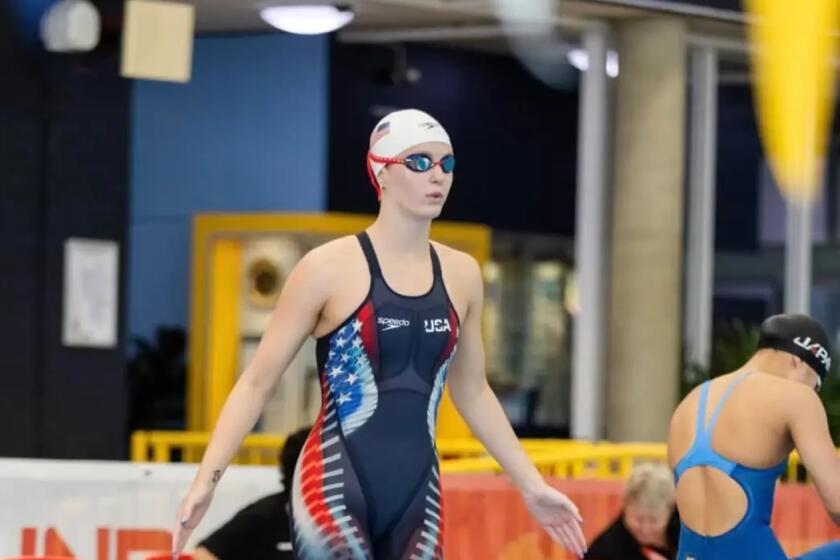Community Colleges Hope for Stability : Releaguing Put to the Test Again
- Share via
For years it has been referred to caustically as “releaguing.”
In community college athletic circles the word has meant controversy, and the last time state administrators talked seriously about realigning its conferences, the fallout almost caused a war.
But this past fall, a decade after its last serious attempt at change, the California community colleges finally implemented a comprehensive conference realignment that many believe will, in time, sooth the in-fighting of the past 40 years and bolster sagging attendance at athletic events.
“Releaguing in California has been a constant battle,” said Fred Baer of the JC Athletic Bureau, an independent ratings service in San Mateo that has followed California’s two-year schools, once referred to as junior colleges, since 1962.
‘Ongoing, Contested Issue’
State community college Commissioner of Athletics Walter Rilliet said the releaguing question never goes away.
“This has been the most ongoing, contested issue in the history of this office,” Rilliet said. “I went back through the records to 1946 of (major) community college athletic meetings, and invariably the meetings eventually dealt with dismantling the conference system.”
As some administrators feared, the new plan did little this fall, particularly for football games in Southern California, to curtail the lack of public recognition for community college athletics. Often grandiose old stadiums held tiny contingents of fans. In today’s cost-conscious college system, it is difficult for some athletic directors to justify the expense in opening a stadium for such little return.
Compton College, which plays at home Saturday afternoons, averaged less than 100 spectators a game. At Long Beach City College, the crowd has never been good in the 12,000-seat Veterans Stadium, averaging less than 1,500 people.
In some cases the reconferencing bolstered old rivalries. In other cases it hampered them. In the South Coast Conference this year, Cerritos College competed against an old nemesis, Long Beach City College, while Long Beach, a founding member of the old Metropolitan Conference, was forced to play traditional rival Bakersfield College in a preseason game.
But the general feeling when the plan passed last year was that it was time to do something, even at the expense of a few traditional games.
The year was 1976 and Omar Scheidt, then president of Cypress College, was hosting a spring forum of the state community college releaguing committee. The task was to realign the state’s more than 100 community colleges into equitable, competitive athletic conferences in the face of soaring oil prices and transportation costs.
The 100 or so administrators, athletic directors, and college presidents agreed that changes were needed to cut travel bills but no school wanted to sacrifice its preferred league match-ups.
For more than three hours Scheidt and his colleagues heard speaker after speaker berate the committee for its “unrealistic, devastating and decimating” choices in league assignments. Several college presidents threatened legal action if a new plan was approved. Others talked of starting their own athletic association.
Like other releaguing proposals before it, Scheidt quickly realized that this one would fail. In his eight years on the committee, he had seen other well-planned proposals fail for the same selfish reasons.
‘Very Frustrating’
“We tried to get the schools to reason,” Scheidt, now a math instructor at Palomar College, said recently in retrospect. “It was very frustrating.”
As Scheidt’s committee discovered, wholesale realignments had previously been bitterly contested from all corners of the state. Only small movements of some schools here and there had been tolerated.
Fallout from the forum in 1976 at Cypress, and at others like it around the state, was so intense that committee members failed to recommend any major changes.
Administrators and presidents, many frightened by change, had fought to maintain the status quo. And in turn, state panels on the subject, often composed of those very same administrators and college presidents, walked timidly for fear of offending their counterparts, who one day might be in a position to retaliate.
Change of Heart
So what brought about the sudden change of heart?
A furor from major football powers got the ball rolling in spring 1983, said Rilliet. The outcry developed after the Committee on Athletics took a bold step by arbitrarily reassigning schools into conferences for football season only.
At the heart of the complaints was the formation of the PAC-9 Conference, which put the traditional football powers in the southern half of the state into one league.
A super conference looked good to the COA on paper, but it brought screams from football coaches who had to face stiff competition each week.
Taken aback by the criticism, the COA announced it would leave the releaguing business and it appointed a new committee, renaming it a conferencing committee.
After much research, the new committee adopted a format that allowed schools to choose the conference they want to compete in, somewhat like that used by the National Collegiate Athletic Assn.
This fall the plan began its first test. The results have been mixed.
The latest conferencing system was burdened by a few problems even before it got off the ground. In Northern California, for example, the new Bay Valley Conference had four schools with football programs because several of its member colleges dropped athletic programs last spring. The Golden Valley Conference had five teams with football. Next year both plan to merge into a conference that covers 90% of Northern California.
A budget crisis in several school districts, including Los Angeles, forced a variety of cuts in sports programs. In the Los Angeles community college district, which once had nine schools with football programs, there are now just two.
“The problem is when you releague in this manner you get some very large conferences and some very small ones,” Baer said.
Yet supporters of the new system remain optimistic that the problems will be worked out.
“Every (releaguing) system has its flaws,” said West Los Angeles College Athletic Director Jim Raack, a former member of the COA. “I think the majority of colleges in the state will make this new plan work.”
But he admits that “there always will be misfits.” In that case, he said, the COA would have to make a decision where to place a school.
Stable Realignment
The goal is a stable realignment that will earn the community college sports programs credibility and boost attendance.
The new system has fallen shy of its stated goal of stability in some areas. Some schools are in one conference for football and in another conference for basketball in the new alignment.
This hurts credibility, community college officials say. An inconsistent approach to releaguing is “a contributing factor” to fan confusion, according to Scheidt.
“An audience follows its team,” he said. “Changes each season do not lend themselves to commitment from an audience as they would have liked.”
Community college officials, although acknowledging that the public is sometimes confused about their programs, had been unwilling to do much about it, until now.
“In the past, releaguing had been a power issue,” Raack said. “Whoever had the most clout, whoever could make the most fuss, got what it wanted.”
Separate Category
It also created a separate category of teams, which Rilliet says fostered a separate class of competition. “Some (of the schools) are stronger than the others,” he said.
The success of the new system hinges on whether it can compete for spectators. If there is renewed fan interest, then officials expect more media attention.
But if that doesn’t work, then this releaguing plan may simply force another wholesale shift in 1988. Built into the current system is a clause that allows a “shopping period” from Oct. 1 to Dec. 1, 1987, when schools can legally seek to leave or join a conference.
That’s when the state should find out whether the new plan has succeeded or not.
More to Read
Get our high school sports newsletter
Prep Rally is devoted to the SoCal high school sports experience, bringing you scores, stories and a behind-the-scenes look at what makes prep sports so popular.
You may occasionally receive promotional content from the Los Angeles Times.






